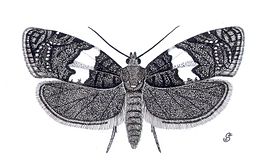Polyorthini
| Polyorthini | ||||||||||||||||||||||||||||||||
|---|---|---|---|---|---|---|---|---|---|---|---|---|---|---|---|---|---|---|---|---|---|---|---|---|---|---|---|---|---|---|---|---|
 Fehérsávos sodrómoly (Olindia schumacherana)
| ||||||||||||||||||||||||||||||||
| Rendszertani besorolás | ||||||||||||||||||||||||||||||||
| ||||||||||||||||||||||||||||||||
| Nemek | ||||||||||||||||||||||||||||||||
|
lásd a szövegben | ||||||||||||||||||||||||||||||||
| Hivatkozások | ||||||||||||||||||||||||||||||||
A Wikifajok tartalmaz Polyorthini témájú rendszertani információt. A Wikimédia Commons tartalmaz Polyorthini témájú kategóriát. |
A Polyorthini a sodrómolyfélék Chlidanotinae alcsaládjának egyik nemzetsége.
Származásuk, elterjedésük
[szerkesztés]A nemzetség 24 nemébe 2013-ban mintegy 150 fajt soroltak, ez a sodrómolyfélék (Tortricidae) fajainak kevesebb mint 1 %-a. Mivel a fajok elsöprő többsége neotropikus vagy ausztrálázsiai, bizonyosra vehető, hogy számos faj még leíratlan. Európában két nem (Isotrias 7 fajjal, Olindia 1 fajjal) található meg.[2]
Megjelenésük, felépítésük
[szerkesztés]Male genitalia are characterized by large, rather membranous valvae with a deep longitundinal invagination within which a large hairpencil from the eighth segment is contained, and a finely bristled or spined anellus. Males lack a forewing costal fold, but in both sexes rows or tufts of raised scales are present (similar to those found in many Tortricini). In several genera the labial palpi are exceedingly long and porrect. The monophyly of the tribe is strongly supported by the unique features of the male genitalia mentioned above, and with the exception of the brightly colored species of Pseudatteria, most Polyorthini have an Acleris-like forewing pattern (EOL)
Életmódjuk, élőhelyük
[szerkesztés]Rendszertani felosztásuk
[szerkesztés]- Apura
- Ardeutica
- Biclonuncaria
- Chlorortha
- Clonuncaria
- Cnephasitis
- Ebodina
- Epelebodina
- Histura
- Histurodes
- Isotrias
- Lopharcha
- Lophoprora
- Lypothora
- Olindia
- Polylopha
- Polyortha
- Polyvena
- Pseudatteria
- Pseuduncifera
- Scytalognatha
- Sociosa
- Thaumatotoptila
- Xeneboda
Magyarországi fajok
[szerkesztés]Magyarországon a nemzetségnek három faja él:
- Olindia (Guenée, 1845)
- fehérsávos sodrómoly (Olindia schumacherana Fabricius, 1787) — Magyarországon szórványos (Pastorális, 2011);
- Isotrias (Meyrick, 1895)
- cifra sodrómoly (Isotrias hybridana Hb., 1817)— Magyarországon közönséges (Buschmann, 2004; Pastorális, 2011; Pastorális & Szeőke, 2011);
- törtsávú sodrómoly (Isotrias rectifasciana Haworth, 1811) — Magyarországon szórványos (Pastorális, 2011);
Jegyzetek
[szerkesztés]- ↑ Index to Organism Names (ION)
- ↑ Fauna Europaea: Polyorthini. [2015. június 10-i dátummal az eredetiből archiválva]. (Hozzáférés: 2013. november 20.)
Források
[szerkesztés]- EOL: Encyclopedia of life: Polyorthini
- Horváth, 1997: HORVÁTH Gyula János: Újabb adatok a Szigetköz lepke faunájának ismeretéhez
- Fazekas, 2001: FAZEKAS IMRE: Somogy megye molylepke faunája
- Buschmann, 2004: BUSCHMANN FERENC: A Mátra Múzeum molylepke-gyűjteménye II.
- Mészáros, 2005: Mészáros Zoltán: A magyarországi molylepkék gyakorlati albuma
- Pastorális, 2011: Pastorális Gábor: A Magyarországon előforduló molylepkefajok jegyzéke. Microlepidoptera.hu 3: 37–136. (2011.09.30.) HU ISSN [https://portal.issn.org/resource/ISSN/2062-6738 2062-6738]
- Pastorális & Szeőke, 2011: Pastorális & Szeőke: A Vértes hegység molylepkéi

